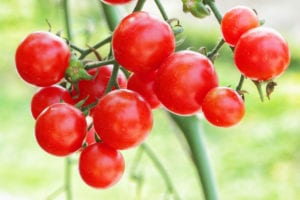Written by Harold Oster, MD. Results suggest that lycopene consumption is associated with a lower risk of liver disease.
 Non-alcoholic fatty liver disease (NAFLD), also called metabolic-dysfunction-associated steatotic liver disease, is one of the leading causes of cirrhosis and end-stage liver disease. It is distinguished by steatosis of the liver and various degrees of fibrosis, in the absence of alcohol consumption at the level considered significant enough to cause alcoholic liver disease (ALD)1. Alcohol consumption is responsible for approximately half of all cases of liver disease in the world2. Lycopene, a carotenoid pigment found in fruits and vegetables, especially tomatoes, has anti-oxidant properties and may have health benefits, including preventing or slowing the progression of NAFLD3.
Non-alcoholic fatty liver disease (NAFLD), also called metabolic-dysfunction-associated steatotic liver disease, is one of the leading causes of cirrhosis and end-stage liver disease. It is distinguished by steatosis of the liver and various degrees of fibrosis, in the absence of alcohol consumption at the level considered significant enough to cause alcoholic liver disease (ALD)1. Alcohol consumption is responsible for approximately half of all cases of liver disease in the world2. Lycopene, a carotenoid pigment found in fruits and vegetables, especially tomatoes, has anti-oxidant properties and may have health benefits, including preventing or slowing the progression of NAFLD3.
Rossella Donghia et al. studied the association between lycopene consumption and liver disease. The authors analyzed data from the NUTRIHEP study, a cohort study conducted by the Laboratory of Epidemiology and Biostatistics of the National Institute of Gastroenterology at the Saverio de Bellis Hospital in Italy4. Participants in NUTRIHEP were evaluated in 2004 and 2005 for dietary habits, demographics, lifestyle factors, medical history, and body mass index. From 2014 to 2018, participants were asked to participate in a follow-up evaluation, which included a liver ultrasound. NAFLD was diagnosed if there was steatosis on the ultrasound in the absence of significant alcohol consumption. If there was steatosis and a history of alcohol consumption above 30 g/day for men or 20 g/day for women, participants were diagnosed with ALD. Participants with liver disease, including steatosis, steatohepatitis, fibrosis, or cirrhosis from any cause, were diagnosed with fatty liver disease (FLD). Participants were divided into three groups: individuals without liver disease, those with NAFLD, and those with either ALD or FLD. Lycopene consumption from cooked or fresh tomatoes was assessed with dietary questionnaires given at baseline compared to a United States Department of Agriculture database of nutrients in food.
The authors noted the following:
- Based on inclusion criteria, data from 969 participants was analyzed.
- After adjustment for covariables, lycopene consumption as a continuous variable was associated with a lower risk of NAFLD and either ALD or FLD. (Relative risk ratio [RRR] of 0.96 and 0.94, respectively)
- Participants who consumed between 9.5 mg/day and 10.0 mg/day of lycopene (the amount in about four medium fresh tomatoes) had the lowest risk of NAFLD and either ALD or FLD. (RRR compared to less than 9.5 mg/day of 0.59 and 0.40, respectively)
Results suggest that lycopene consumption is associated with a lower risk of liver disease. Limitations of the study include the observational design, reliance on dietary questionnaires, the lack of assessment of lycopene consumption from foods other than tomatoes, and possible residual confounding.
Source: Donghia, Rossella, Angelo Campanella, Caterina Bonfiglio, Francesco Cuccaro, Rossella Tatoli, and Gianluigi Giannelli. “Protective Role of Lycopene in Subjects with Liver Disease: NUTRIHEP Study.” Nutrients 16, no. 4 (2024): 562.
© 2024 by the authors.Licensee MDPI, Basel, Switzerland. This article is an open access article distributed under the terms and conditions of the Creative Commons Attribution (CC BY) license (https://creativecommons.org/licenses/by/
4.0/).
Click here to read the full text study.
Posted March 13, 2024.
Harold Oster, MD graduated from medical school in Miami, Florida in 1992 and moved to Minnesota in 2004. After more than 25 years of practicing Internal Medicine, he recently retired. Dr. Oster is especially interested in nutrition, weight management, and disease prevention. Visit his website at haroldoster.com.
References:
- Chan WK, Chuah KH, Rajaram RB, Lim LL, Ratnasingam J, Vethakkan SR. Metabolic Dysfunction-Associated Steatotic Liver Disease (MASLD): A State-of-the-Art Review. J Obes Metab Syndr. Sep 30 2023;32(3):197-213. doi:10.7570/jomes23052
- Roerecke M, Vafaei A, Hasan OSM, et al. Alcohol Consumption and Risk of Liver Cirrhosis: A Systematic Review and Meta-Analysis. Am J Gastroenterol. Oct 2019;114(10):1574-1586. doi:10.14309/ajg.0000000000000340
- Imran M, Ghorat F, Ul-Haq I, et al. Lycopene as a Natural Antioxidant Used to Prevent Human Health Disorders. Antioxidants (Basel, Switzerland). Aug 4 2020;9(8)doi:10.3390/antiox9080706
- Bonfiglio C, Campanella A, Donghia R, et al. Development and Internal Validation of a Model for Predicting Overall Survival in Subjects with MAFLD: A Cohort Study. Journal of clinical medicine. Feb 19 2024;13(4)doi:10.3390/jcm13041181
